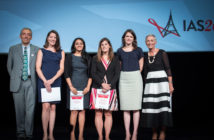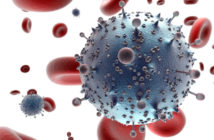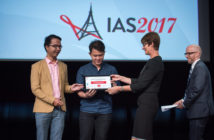The most pressing gaps in research needed to improve outcomes for children and adolescents living with HIV are highlighted in the first global priority research agendas on paediatric and adolescent HIV, released at the 9th IAS Conference on HIV Science (IAS 2017) yesterday, 23rd July, 2017.
The International AIDS Society’s (IAS’s) Collaborative Initiative for Paediatric HIV Education and Research (CIPHER) and the World Health Organization (WHO) developed the new priority research agendas, entitled “Research for an AIDS-Free Generation: A Global Research Agenda for Paediatric HIV” and “Research for an AIDS-Free Generation: A Global Research Agenda for Adolescents Living with HIV.” They were shaped through a global process led by a working group of experts, and informed by consultations with researchers, healthcare workers, donors, civil society representatives, policy makers and global organizations.
The new guidance represents an international consensus on the top priority questions in testing, treatment and service delivery for children and adolescents living with HIV. The guidance is designed to inform the work of all stakeholders involved in funding, supporting or conducting clinical and operational research in paediatric and adolescent HIV worldwide.
“Everything we know about the paediatric and adolescent HIV epidemics point to the need for more and better tailored research to address the many clinical and implementation research questions that remain unanswered in the global response,” IAS President Linda-Gail Bekker said. “These priority research agendas can help answer the most pressing questions in the field, streamline research, maximize investments, inform important policy changes and, ultimately, improve the lives of infants, children and adolescents living with HIV.”
HIV testing and treatment rates are lower for children and adolescents than for adults. Only 43% of children living with HIV are accessing antiretroviral treatment (ART), and only 43% of HIV-exposed infants are tested by the recommended age of two months. In 2016, 260,000 adolescents became infected with HIV. With the successful scale up and effectiveness of ART, more children living with HIV are growing into adolescence and require ongoing support to remain in care and adhere to ART.
“We must take action now to close the gaps in the HIV response for children and adolescents, to deliver better HIV prevention, treatment and testing to those in greatest need,” WHO HIV Department Director Gottfried Hirnschall said. “The IAS/WHO process has helped us to define priority areas for further research, to inform global policies and implementation to bring us closer to an AIDS-free generation for infants, children and adolescents.”
Research priorities for infants and children
“Research for an AIDS-Free Generation: A Global Research Agenda for Paediatric HIV” identified the following as the top research priority areas for infants and children living with and affected by HIV in the areas of testing, treatment and service delivery:
Testing
- Optimal placement and timing of novel diagnostic tools for point-of-care use
- Interventions to ensure timely linkage between HIV diagnosis, treatment and care
- Interventions or strategies to improve access to and uptake of HIV testing services for infants and children, particularly community-based approaches
- Factors that enable or hinder linkage to care and timely initiation of ART
- Effective, feasible and acceptable testing strategies (including routine testing at birth) at entry points other than antenatal care for identifying undiagnosed HIV- positive infants and children in different epidemic settings.
Treatment
- Safety, efficacy, acceptability, pharmacokinetics and optimal dosing of existing and new antiretroviral drugs and formulations, particularly with novel drug delivery systems
- Strategies or interventions to improve adherence, and factors that affect their success
- Optimal prevention and clinical management of co-infections, particularly tuberculosis
- Impact of HIV infection and ART on short- and long-term outcomes, in particular non-communicable disease
- Short- and long-term virologic and immunologic outcomes of starting very early treatment in infants living with HIV (impact on functional cure).
Service delivery
- Strategies or interventions to improve access to, uptake of and retention in care, and factors that impact their success
- Service delivery models to improve individual and programmatic outcomes along the HIV cascade, including integration of comprehensive HIV treatment and care into the maternal and child health platform
- Psychosocial and family support strategies or interventions to improve individual and programmatic outcomes
- Strategies or interventions to improve and support parents, caregivers and healthcare providers to facilitate HIV disclosure to children, as well as factors that impact their success
- Strategies or interventions to reduce stigma and discrimination experienced by children and their caregivers.
Research priorities for adolescents
“Research for an AIDS-Free Generation: A Global Research Agenda for Adolescents Living with HIV” identified the following research priorities for adolescents living with HIV in the areas of testing, treatment and service delivery:
Testing
- Strategies and interventions to improve access to and uptake of HIV testing services, and factors that impact their success
- Strategies and interventions to improve linkage of newly diagnosed adolescents to HIV treatment, and factors that impact their success
- Safe and acceptable strategies or interventions to improve access to and uptake of HIV testing services for adolescents from key populations
- Consent policies and practices to facilitate access to and uptake of HIV testing services in adolescents
- Safety, acceptability, feasibility and effectiveness of self-testing.
Treatment
- Effective monitoring approaches and strategies to improve adherence among adolescents and factors that impact their success
- Safety, efficacy and acceptability of novel drug delivery systems
- Prevention and clinical management of co-infections, particularly tuberculosis
- Optimal sequencing of ART in adolescents
- Impact of HIV infection and ART on short- and long-term outcomes of adolescents, in particular non-communicable disease.
Service delivery
- Interventions to improve retention in care, and factors that affect success
- Strategies or interventions to improve sexual and reproductive health outcomes in adolescents living with HIV
- Strategies or interventions to support pregnant adolescents living with HIV and improve both maternal and child health outcomes
- Service delivery models to improve outcomes along the HIV cascade, including peer interventions and differentiated service delivery models
- Psychosocial support strategies or interventions to improve individual and programmatic outcomes.
Beyond the recommendations
In addition to highlighting the most urgent area for research focus in paediatric and adolescent HIV, the new agendas also make recommendations to maximize the impact of new and ongoing research efforts in the field. Included are recommendations to:
- Strengthen national monitoring and evaluation systems to obtain the age-disaggregated data needed to support monitoring and inform effective policies and programmes
- Improve programmatic data to help measure the impact of new strategies and determine what works best in specific contexts
- Increase the participation of civil society and community-based organizations, especially in implementation research, advocacy and service delivery
- Support innovative trial design approaches, when appropriate, to expedite results
- Investigate innovative strategies, such as using observational data and big data collaborations to inform policy and programme decision making
- Better utilize modelling to help bridge data gaps and maximize the value of existing information
- Continue innovation in basic and implementation science to develop new tools and increase the effectiveness of care to end paediatric HIV.
The documents will be published, along with more information on the agenda-development process, on the IAS CIPHER website (https://www.iasociety.org/CIPHER). A special supplement to the Journal of Acquired Immune Deficiency Syndromes (JAIDS), dedicated to the guidelines and including a series of related articles, will be published in May 2018.




